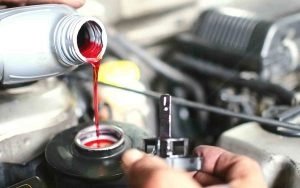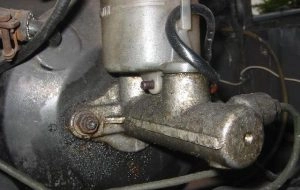Brake oil is one of the essential components of any brake system in a car. It works to increase the pressure inside the pipes and hydraulic cylinders, transforming mechanical force into stopping power.
It is very important to keep your car's brake fluid healthy and free from damage, so that the system can operate efficiently and the car can be controlled better. Following, we will discuss 6 signs that indicate the damage of the car's brake fluid.
Signs of Brake Oil Damage

Brake oil becomes dark and murky.
The oil becomes dark and opaque when exposed to impurities and various contamination during the normal operation of the vehicle. The brakes use frictional force to stop, and in doing so, they generate heat and friction and cause wear to different parts. This results in the release of impurities and deposits within the brake system.
Over time, these impurities and deposits accumulate in the brake oil, making it dark and opaque. When this happens, it affects the efficiency of the brake system, increasing the stopping distance and reducing the pressure exerted by the driver on the brake pedal.
To maintain the efficiency of the braking system, it is necessary to regularly refill the car's brake oil and carry out periodic oil changes based on the schedule set by the manufacturer. You can also use oil filters specifically for the braking system to eliminate impurities and excess pollution in the oil.
2- The impact of corrosion on brake fluid
Continuous wear on the parts of the brake system leads to the generation of heat and excessive friction, which in turn leads to the degradation of brake fluid and negatively affects the efficiency of the brakes.
The quality of a car's brake oil is affected by the corrosion of metal parts in the brake system, as the oil flows through the corroded brake parts, collecting deposits and impurities formed on the corroded parts and present within the oil.
This leads to the accumulation of deposits inside the car's brake fluid, which increases the level of corrosion on the metal parts and affects the efficiency of the brakes, sometimes leading to brake failure.
To maintain the efficiency of the brake system, regular maintenance should be carried out, including regularly replacing the car's brake fluid, checking worn parts, and replacing them if necessary to prevent excessive wear and ensure brake safety.
3- Brake fluid leak

A leaking car brake fluid is among the common issues that vehicles face. This leak could occur due to high pressure inside the brake hose or the brake bushing, or because of the wear of the brake gasket.
A leak in the car's brake oil leads to a decrease in pressure within the system, affecting the efficiency of the brakes and causing an increase in stopping distance. It can also result in loss of control over the vehicle and increase the risk of accidents.
To avoid brake fluid leakage, it is necessary to regularly inspect the brake hoses and bushings and replace them if there is any damage or cracking. The brake gasket should also be replaced when it wears out and any leaks must be repaired immediately to maintain the efficiency of the brake system and prevent accidents.
4- Strange noise while braking
A strange noise may occur when braking due to numerous reasons, one of the most significant being the wear of the brake pad. When the pad wears down, a metallic or sharp sound can occur during braking.
In addition, the cause could be deposits or dirty parts on the brakes, leading to deformations or damage to the metal surfaces and causing a strange noise during braking.
The real reason for the strange noise during braking, which might require maintenance of the brake oil system, should be identified. This includes checking and cleaning the brakes, and replacing the brake pads when they are worn out.
5- Rising brake temperature
If the brake temperature is higher than usual, this may be a sign of brake fluid damage, as high temperature leads to oil degradation and deposit formation, which results in loss of brake efficiency and an increased risk of traffic accidents.
You should check the temperature of the brakes by touching the wheels after long periods of driving. If you notice an increase in the brake temperature, it is important to have the system inspected by a specialized technician.
6- The brake pedal is soft or rubbery or spongy.
A soft, rubbery, or spongy brake pedal is a sign of damage to the hydraulic system in the brake oil system. When pressing the pedal, the pressure should be constant and stable without any sensitivity.
If the pedal feels soft or rubbery or spongy, this could be a sign that there is air in the hydraulic system or damage to the hoses, cavities, or pipes. This can lead to a loss of brake efficiency and an increased risk of traffic accidents.
Therefore, the hydraulic system should be inspected by a specialized technician and the necessary repairs should be carried out. This issue can be remedied by replacing the air in the hydraulic system by bleeding the brake lines and refilling the oil. Damaged hoses, cavities, and pipes can also be replaced to improve brake efficiency and prevent traffic accidents.
By paying attention to these signs indicating damage to the car's brake oil, maintenance can be maintained.Brake System Correctly and safely control the car with high efficiency. Attention must be paid to Change the brake oilRegularly, according to the car manufacturer's instructions, have the system regularly checked by a specialized technician to avoid any damage or problems with the brakes.

Comments